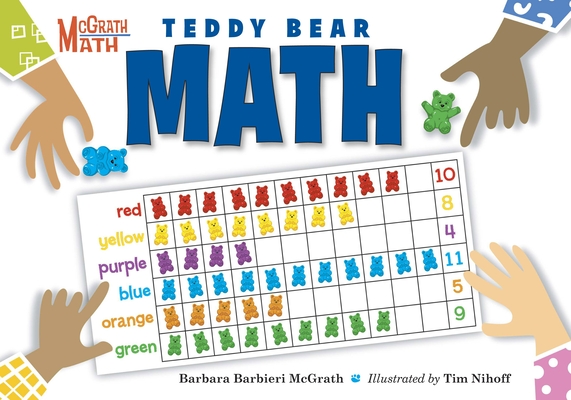You are here
Back to topTeddy Bear Math (McGrath Math #2) (Hardcover)
$16.95
Special Order
Description
Colorful teddies
make great counting tools.
Grab four big handfuls,
then follow the rules.
In a follow-up to Teddy Bear Counting, young learners can build on their math skills with their colorful teddy bear friends. Math concepts include sorting, graphing, counting, adding, subtracting, multiplying, and dividing. Even kindergartners can learn complicated math skills easily with these bouncy rhymes, familiar teddy bear manipulatives, and step-by-step instructions that make learning math fun and exciting.
Simple, bright illustrations show children how to set up their teddy bear sets, graphs, and equations, with plenty of white space to make each step clear. Cute teddies and a few helping hands will ensure that little ones can’t wait to go back to the beginning and do more math!
About the Author
Barbara Barbieri McGrath has written over twenty books for children, including The Little Gray Bunny, The Little Red Elf, The Little Green Witch, and many bestselling math concept books. Her love for writing, children and making learning fun was the inspiration for her first children's book, The M&M Brand Counting Book, which sold over 1 million copies. She lives in Natick, Massachusetts.
Tim Nihoff is the illustrator of Otter Everywhere(Candlewick). He is also a graphic designer and sculptor who creates toys, furniture, and other "fun fine art" from found objects. Tim lives and works on a small island in Maine.
Praise For…
The colorful, chunky bears that first appeared in Teddy Bear Counting introduce more advanced concepts like estimation, graphing, division, and multiplication in this squat book. McGrath uses rhyming verse to guide readers; on a spread containing a graph with the glinting beards divided by color, she advises: "Write down the total/you see in each row./Let's see if your guess/was too high or too low." Nihoff incorporates digital hands that point to and reach for the bears, emphasizing their resemblance to counting manipulatives. Though the beards feel surprisingly animated (especially when they open their arms and tumble in air), the book will be most effective when used with the bears' plastic counterparts (not included).
—Publishers Weekly
Similar in style to McGrath's Teddy Bear Counting, this picture book uses a rainbow of bears to explore sorting, graphing, addition and subtraction, multiplication and division, and ordinal numbers. Despite the rhyming text and bright illustrations hand drawn digitally in Adobe Photoshop, readers may get more out of Stuart J. Murphy's "MathStart" series (HarperCollins) or Greg Tang's math riddle books (Scholastic), where one concept is introduced as the topic for the book rather than several at once. This book would ake a great preview to using bear counters as math tools and is best suited for early-learning classrooms where children have access to these manipulatives.
—School Library Journal
Teddy Bear Math is a colorful book for children ages 5–8 that uses teddy bear counters to illustrate estimation, addition, subtraction, multiplication, and division. Graphing, comparing, and ordinal numbers are also included. The book could be used by teachers when working with teddy bear counters or other manipulatives. Each concept would need multiple representations to be sure children are understanding it. The excellent illustrations by Tim Nihoff and the rhyming prose make it a good read-aloud book, especially if the reader allows time for interaction from the children who are listening.
The design of the book might lead one to assume that it is appropriate for a younger audience. However, the speed and depth with which the mathematics is presented makes the book most appropriate for the indicated age level. Younger children might appreciate Teddy Bear Counting by the same author and illustrator.
—Teaching Children Mathematics
